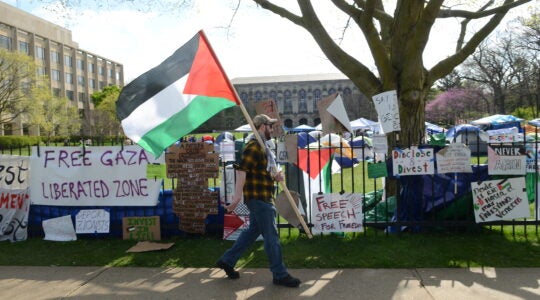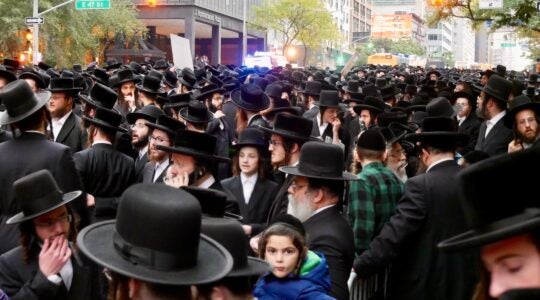PHILADELPHIA (Jewish Exponent) — Nearly 40 years after it was last used, a tiny synagogue at the historic Eastern State Penitentiary in Philadelphia has been restored and is now open to the public.
Believed to the first prison synagogue built in the United States, the chapel at Eastern State was built circa 1924 at the urging of Alfred Fleisher, a Jewish businessman and philanthropist who was president of the prison’s board of trustees from 1924 until 1928. Fleisher promoted and attended all of the Jewish holiday services held at Eastern State.
But after the prison was abandoned in 1971, the facility and its synagogue stood in near ruin, a haunting, ghostly maze of crumbling cell blocks, empty guard towers and dark corridors.
Restoration began in the 1980s, and the prison opened for daily tours in 1994, drawing 190,000 visitors last year. The synagogue, however, remained forgotten, even as work began to preserve other parts of the site.
“Entering the synagogue for the first time, I was struck by the romance of its ruinous state,” wrote Laura Mass, an architectural conservator who researched the synagogue’s history. “Years of neglect and water infiltration had resulted in severe deterioration of the space. Wood elements were splintered and rotted. Plaster was detaching from the walls. Almost all of the ceiling had collapsed. Yet evidence of the room’s past use stood out in defiance of this ruin.”
The synagogue’s fortunes began to change in 2002 when Cindy Wanerman, now president of the prison’s board of directors, spotted the synagogue on the prison map and was taken to see it. Wanerman said that when she first saw the room, it reminded her of the bombed-out synagogues in Poland from World War II.
After consulting a rabbi, Wanerman explained that as a Jew, she felt an obligation to help take care of the abandoned synagogue, where “decay has taken a toll.”
She set to work raising funds, and since 2004 helped bring in the $280,000 needed to restore the synagogue. Many of those who donated, she noted, were descendants of the prison’s chaplains, rabbis or volunteers, or other members of the local Jewish community.
“God gave me a job,” Wanerman, a member of Temple Sinai in Dresher, Pa., said of her efforts. “It just had to get done. We would have lost this place if we didn’t do this now. Because of the condition it was in, we couldn’t wait 10 years.”
Earlier this month, the prison synagogue was opened to the public after months of intense restoration work.
A dedication ceremony was scheduled for what is now known as the Alfred W. Fleisher Memorial Synagogue; the ceremony was slated to include the affixing of a mezuzah to the synagogue’s outside door frame. Rabbi Jonathan Gerard, Jewish chaplain at the State Correctional Institution at Graterford, was expected to speak about counseling inmates in a maximum-security prison.
“Standing in the synagogue today, I feel a tremendous sense of accomplishment,” Mass wrote. “And I feel fortunate to have played a role in a collaborative effort to honor this site and share it with others.”
Religion was an important component of life at Eastern State, according to Sean Kelley, program director at the site. He noted that prison records show that as early as 1837, a rabbi had visited Jewish inmates to offer spiritual guidance.
Although Eastern State didn’t hold many Jewish inmates, he reported — at its peak, there were no more than 80 Jews in a prison that held roughly 1,500 inmates, but usually it hovered at about 20 — “there was always some Jewish life here in the building.”
Originally a handful of Jewish prisoners gathered at the small emergency hospital for services that were offered for Passover, Yom Kippur and other holidays; weekly Shabbat services were added later. Fleisher eventually got a formal synagogue built more than 100 years after the prison had opened.
The synagogue — the length of four adjoining cells — was built off a cellblock in a space that had served as individual exercise units in the days of solitary confinement.
“It’s a very, very small room,” Kelley said of the 34-foot-by-15-foot room, which he called “a precious little space.”
Much of the history of the synagogue was uncovered by Mass, who led an excavation of the room as part of her 2004 graduate thesis in historic preservation at the University of Pennsylvania. Her research into the history and building materials has been used to determine what the restored synagogue should look like.
“It felt important to me to do a topic that was Jewish,” said the native New Yorker. “I’m very fortunate that my thesis topic is being restored. It’s very exciting.”
Rabbi Martin Rubenstein, the prison’s last Jewish chaplain, told The New York Times that the synagogue helped inmates feel connected to their families and their Jewish traditions.
“It was important,” Rubenstein told the Times, “for them to feel that the community was still there and that we were there to help them.”
(Michelle Mostovy-Eisenberg is a staff writer for the Jewish Exponent of Philadelphia.)
JTA has documented Jewish history in real-time for over a century. Keep our journalism strong by joining us in supporting independent, award-winning reporting.





